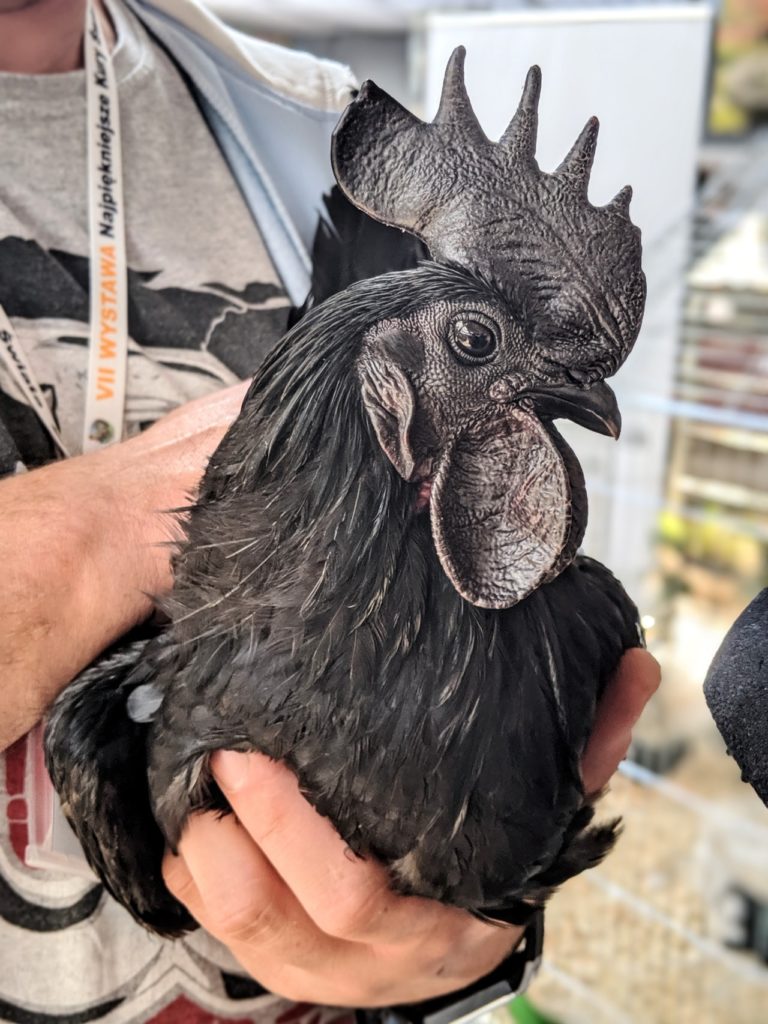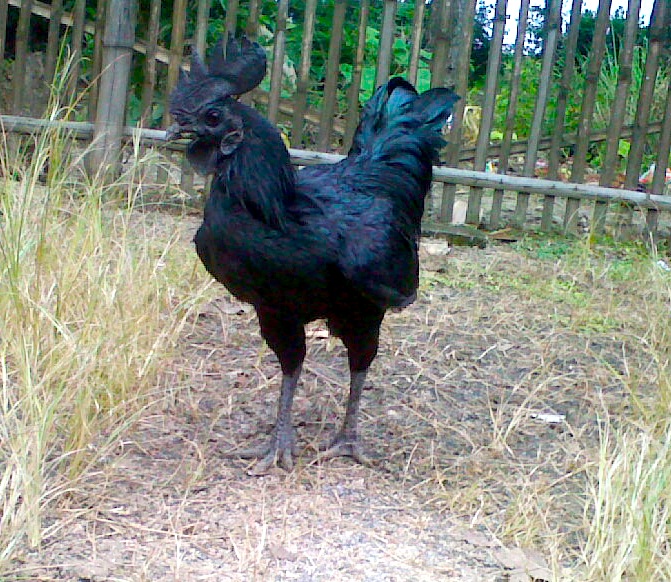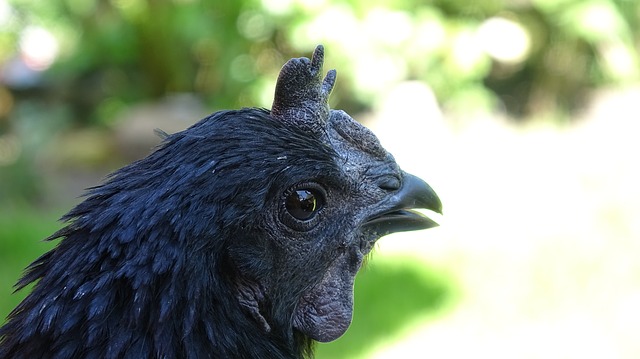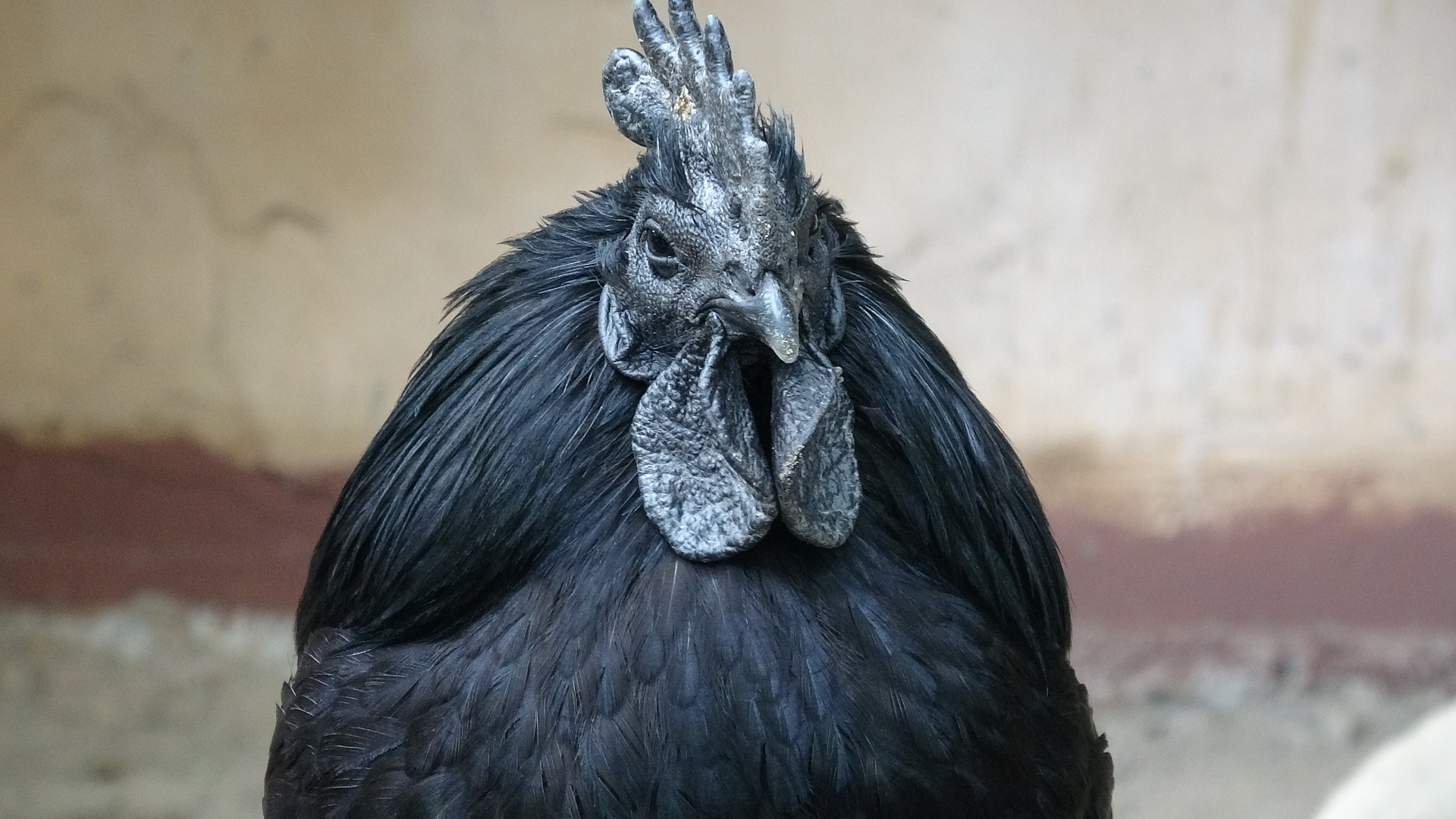The Ayam Cemani is a gorgeous black bird with the mystical reputation – but does it have a place in your backyard flock?
If you’ve been searching for the right chicken to round out your coop, the Ayam Cemani might be for you.
But don’t rush to the hatchery website to order your birds just yet – this unusual bird can be tough to find, and even more challenging to raise.
Yet the challenges are worth it.
The Ayam Cemani is one of the rarest and most luxurious chicken breeds you can raise.
Ayam Cemani Chickens Overview
Here’s some standard information about the rare Ayam Cemani chicken breed.
| Lifespan | 6 to 8 years |
| Weight | 3.5 to 6.5 pounds |
| Appearance | Completely black |
| Egg Color | White/cream |
| Egg Production | One per week, 80 per year |
| Good for Beginners? | No |
| Minimum Coop Size | 4 square feet per bird |
| Price | About $200 per chick, $5,000 per adult pair |
A Quick Background of Ayam Cemani Chickens

The Ayam Cemani is believed to have originated in Sumatra. They’re known as a rare breed, and the most beautiful black chicken breed.
Related to a small subsection of chicken breeds that is referred to as Kedu, this bird may have developed and originated on Java’s central plains, where it descended from the majestic Ayam Bekisar breed of chicken.
However, it’s tough to pinpoint the exact origins of this exotic bird, since it is now extinct as an original breed in Sumatra.
A combination of jungle fowl in green shades and domesticated red fowl, this bird is part of a family of chickens that has a distinct crowing noise and was put to work by early voyages as a foghorn on ships.
Beliefs Associated with the Ayam Cemani Chicken
“Ayam” translates to the word “chicken” in the Indoneisan language, but the latter part of the name, Cemani, is more ambiguous.
It can refer to the village of Cemani or to the phrase “solid black.”
Revered in Javanese folklore since the 1100s, the Ayam Cemani chicken breed is a bird of the elite. Its deep red, nearly black blood is believed to be a good luck charm and a delicacy of the psirts that herald in both wealth and power.
Believed by some to be a landrace bird, the Ayam Cemani chicken was an established breed at one point and time.
Commonly raised by individuals of high social and economic status, this bird is a pet chicken breed that is raised as a symbol of status and luxury.
It’s also often believed to be a good luck charm.
In traditional medicine, the blood, bones, and other portions of the bird are often used to signal good fortune.
The Ayam Cemani chicken breed is believed to have magical powers by some cultures, possessing the unique ability to transfer messages between the living and the dead.
It’s often utilized as a sacrificial bird in Indonesia, but its flesh is hardly ever eaten in this country as well as abroad.
In North America, the breed has a relatively short history. It was only brought to Europe in 1998 and was brought overseas shortly after.
Ayam Cemani Chicken Appearance

The Ayam Cemani is one of the most interesting – yet striking – chicken breeds you could hope to lay eyes upon.
The bird not only has all-black feathers that shine iridescent green in direct sunlight, but they also have black skin, wattles, eyes, comb, feet, bones, and blood.

These chickens are not officially designated as a breed by the American Poultry Association, but the Ayam Cemani Club in the United States has lobbied hard to develop a standard of perfection.
Ayam Cemani Chicken Breed Standards
The Dutch Standard of Perfection dictates the following conditions in a true-blood Ayam Cemani.
- Upright, game-like posture
- Body of a medium size (around 4.5-6.5 lbs for roosters, and 3.5-4.5 for hens)
- Strong, muscular bodies with firm builds
- Close-fitting feathers that are solid black
- Eyes, skin, comb, and wattles that are solid black
- Feathers may look beetle-green or purple in the sunlight
- Broad breast and mediums-ahead, sloping back
- Strong, long wings
- Moderately high tail posture
- Powerful, muscular thighs
- Four toes on each foot
These chickens are not overly large, which makes them unsuitable for most commercial purposes.
However, like a game bird or jungle fowl, they are absolutely lovely to behold and are the perfect choice for a chicken keeper seeking a gorgeous ornamental breed of chicken.
Ayam Cemani Behavioral Patterns
Ayam Cemani chickens aren’t remarkable when it comes to their behavior.
They are low-maintenance and easy to handle.
They can be skittish and flight under some circumstances, but once they become accustomed to your presence you will likely find that this is less so.
These birds are friendly and overall, quite sociable.
Even the roosters tend to be quite docile.
However, both hens and roosters alike are known for being extremely intelligent – you will want to make sure your chicken fences are “Cemani”-proof to make sure you don’t have any escapees!
These chickens are tolerant of both hot and cold weather, shaking off icy conditions as well as insufferable heat with ease.
As long as you provide the appropriate shade and cold-weather housing, you will likely find that your Ayam Cemani is a resilient breed to most weather conditions.
Is the Ayam Cemani Chicken a Good Egg Layer?
Unfortunately, Ayam Cemani chickens are not known for their egg laying abilities.
They will usually only lay around one single Ayam Cemani egg each week – this amounts to a measly 80 eggs each year.
They have a reputation for going off laying for extended periods of time – they might lay twenty-five eggs or so and then completely stop for six months before resuming again.
This behavior does not seem to be influenced by anything in particular – it does not always correspond to broodiness or molting.
This kind of unpredictably can be a major hassle if you are hoping to raise Ayam Cemani eggs.
That being said, the eggs that the Ayam Cemani hen does produce will be rather large, especially when you compare them to the hen’s average size.
The eggs are a white or cream color with a pale pink tinge. There are some myths out there that claim that Ayam Cemani chickens lay black eggs – this, unfortunately, is not true.
Broodiness
Ayam Cemani chickens aren’t known for being broody, but they can occasionally go broody depending on their genetics, environmental conditions, and the coop hierarchy.
When they do hatch the brown eggs, they tend to be good mothers, caring adequately for their young.
Is the Ayam Cemani Chicken Good for Meat?
The Ayam Cemani is commonly raised in Indonesia as sacred animal – as a result, they are highly valued and rarely eaten for meat.
There are those, however, who say that eating the meat of the Ayam Cemani will cure disease and bring good luck to those who consume them.
In most countries, the Ayam Cemani is not raised for its meat, but instead its blood.
The deep red, practically black blood is often used in sacrificial ceremonies – this too is believed to bring good luck.
There are very few chefs in the United States who recognize the culinary benefits of Ayam Cemani chicken meat.
Does Black Meat Taste Different?
The meat, which is jet black, does not offer a distinct advantage in taste over traditional meat – this is a contradiction to other black chicken breeds, like the Silkie, who produce gamey, uniquely-flavored meat.
It is uncommon in the poultry market because, though not unpalatable, it is so expensive.
While Ayam Cemani meat might have a slight taste advantage over pure white chicken meat, its price point is so steep that most chicken owners and chefs wouldn’t choose it when given the choice between Ayam Cemani meat and meat with a lower price tag.
While Ayam Cemani chickens are believed to be good luck, curing a whole host of diseases, you shouldn’t expect the meat of an Ayam Cemani to cure your hunger.
With the average chicken of this breed weighing in at less than five pounds, there’s really not a lot of it.
Health Issues of the Ayam Cemani Chicken
Some people believe that Ayam Cemani chickens will be more predisposed to certain health problems due to their coloring.
This is not the case.
Ayam Cemani chickens have mutant fibro melanistic genes, and while these genes are not common, they are also not dangerous.
Why are Ayam Cemani Chickens Black?
The fibro melanistic gene is simply one that deposits excess black pigment.
As a result, the skin, tissues, and other portions of the Ayam Cemani chicken appear to be black.
There are three other birds that also carry this gene – the Svart Hona chicken from Sweden, the Silkie chicken, and the Kadaknath (a bird from the Madhya Pradesh region of India).
The process of melanization happens in the embryo.
Every aspect of the bird, from its feathers to its onyx feet and even its organs, is affected by the melanization.
The gene mutation responsible for the black coloring produces about ten times as much melanin as you’ll find in a normal chicken.
Even the baby chicks are all black!
Even the blood of this chicken, though not 100% black, is also darker than normal.
The bone marrow, too, is black, giving it a unique appearance if you decide to butcher your Ayam Cemani for meat.
Otherwise, the Ayam Cemani is a healthy, energetic bird. Although it can always fall victim to the same conditions that affect other breeds of chickens – like chicken mites, coccidiosis, or lice – it is not prone to any kind of health condition more than any other breed.
The Ayam Cemani itself is believed to have healing powers – believers in its mystical traits think that the blood of the Ayam Cemani can reverse bad luck and cure a wide variety of physical maladies.
Usually, healing ceremonies are guided by animist gurus, who place the blood in a bowl, prevent it with other offerings, and mutter certain incantations to help heal your body and soul.
Caring for Ayam Cemani Chickens
Here are a few tips for caring for these amazing birds:
Ayam Cemani As Chicks
In the native environment of Indonesia, these chickens are raised in bamboo coops.
However, here in the United States, you can raise Ayam Cemani chickens just as you might your other birds. You can raise them as chicks or as started juveniles.
If you are raising your Ayam Cemani chicks up from hatched eggs, you will need to keep them in a warm brooder (95 degrees Fahrenheit to start, with a reduction by five degrees each week until the temperature is the same as the room’s ambient temperature).
Feed your young Ayam Cemanis chick starter until they are ready to go outside.
Ayam Cemani As Adults
Once you move your Ayam Cemani chickens to the coop, you can feed them either egg layer or broiler feed – this will be determined by your specific individual chickens as well as your ultimate goals in raising your flock.
In the coop, you should provide at least four square feet per bird, but more is better if possible.
You should add supplemental foods like fresh vegetables, fruits, and occasional treats like scratch grain to keep them entertained.
Make sure you provide your chickens with plenty of fresh, clean water, as well as shelter from the elements.
The coop should be well-ventilated and offer protection from predators – although Ayam Cemani chickens are descendants from jungle fowl, they aren’t going to be able to escape the hungry jaws of raccoons, hawks, or foxes.
Keeping your birds in a chicken tractor or covered run is a great way to keep them safe.
Ayam Cemani chickens are not known for being flighty, so you shouldn’t have to worry about clipping wings.
You shouldn’t have to cover your run unless you really want to – while a covered run will provide protection from aerial predators, you don’t need to worry about your birds flying over short fences, for the most part.
Benefits of Raising an Ayam Cemani Chicken
The Ayam Cemani offers numerous benefits to prospective owners.
Its gorgeous appearance aside, it also raises decently sized cream-colored Ayam Cemani eggs for you to enjoy.
You may be able to hatch your own chicks with one of these chickens as a broody mother, too.
This chicken is relatively docile, making it easy to handle and interact with – you don’t have to worry about any ornery roosters here.
It is active and not overly flighty, so you may not have to have a super tall fence or enclosed run in order to keep this bird contained.
It tolerates confinement well, performing quite well when raised in close proximity to other birds.
This breed of chicken is also exceptionally cold-and heat hardy.
When given the proper conditions, it can handle free-ranging in both settings with ease.
And although this chicken looks haunting – and yes, somewhat creepy! – it is actually quite a friendly, good-natured bird.
Challenges of Raising an Ayam Cemani Chicken
One of the biggest difficulties that might arise in raising an Ayam Cemani chicken is that it can be exceptionally expensive.
If you decide to purchase an unsexed chicken, it can easily cost you $200 – a sexed juvenile will be twice that amount. A pair of adult chickens can cost as much as $5,000, making them one of the most expensive chicken breeds.
Therefore, this bird is not for the faint of heart or budget-conscious.
It’s also not recommended that you decide to raise the Ayam Cemani if you are new to raising chickens.
This is not because there is anything more difficult about raising this bird than there is in raising any other breed, but because the birds of this breed are so expensive.
You will be taking on some serious risk if you decide to front the money for one of these birds.
They are also difficult to find.
While they are commonly found and bred in Indonesia, there are lots of restrictions in place on their importation, especially in lieu of the avian influenza outbreak.
While they are commonly bred in Europe and America as well, they tend to be much smaller in numbers.
It’s estimated that there are fewer than 4,000 of these birds in the world today.
How to Find a True Ayam Cemani Chicken
Greenfire Farms in the United States claims to be the first to legally import pure Ayam Cemani chickens into the United States.
While you can sometimes find cheaper specimens for sale, you need to be careful – often, you get what you pay for, and when you raise your Ayam Cemani to maturity you might find that it loses some of its black coloring or does not display all the proper characteristics of a true member of this breed.
You also may have difficulties producing purebred offspring in this case, too.
How do you know if you have a purebred Ayam Cemani?
You probably won’t – at least until you cut the chicken open, if you’re raising it for meat. A true Ayam Cemani will be jet-black inside and out.
If you’re purchasing from a respected, reputable breeder, expect to wait at least six months on a waiting list before you receive one of these unique birds.
These chickens are often raised as pets, but know that they aren’t really the friendliest of all chickens.
They aren’t antisocial or aggressive in any way, but they aren’t going to cuddle up to you like a Silkie chicken might.
And because they aren’t usually raised for purposes besides ornamentation, this might be a frustrating experience for you to deal with.
Frequently Asked Questions
Ayam Cemani chickens are a rare breed with lots of beauty, but they can be a lot of work. So, here are some questions you might be wondering before you make a decision.
How Much Do Ayam Cemani Chickens Cost?
Not many chicken breeders have Ayam Cemani chickens available, so an adult pair can cost as much as $5,000. Unsexed chicks are the most affordable, ranging between $50 and $200 per bird. Every breeder will price them differently.
How Many Ayam Cemani Chickens Exist Today?
There are only about 3,500 Ayam Cemani chickens known today. They can be found all over the world, but it’s hard to find one to buy.
Do Ayam Cemani Chickens Lay Black Eggs?
No, Ayam Cemani Chickens do not lay black eggs. Even though they’re completely black from head to toe, they lay white or cream eggs. There aren’t any chicken breeds that lay black eggs.
Is an Ayam Cemani Right for Your Flock?
Although the Ayam Cemani chicken breed has been around for centuries, this bird is growing in popularity as it has come to the recent attention of chicken lovers in the west.
It is one of the most unique – and rarest – exotic breeds you can raise, and while it’s difficult to ship to the United States, it’s the one you should absolutely consider if you want a chicken that will stand out among the rest of your flock.
So what are you waiting for?
Get your name on a waiting list for an Ayam Cemani chicken.
We promise that raising one of these elegant “gothic” birds is well worth the wait – and the price tag!
